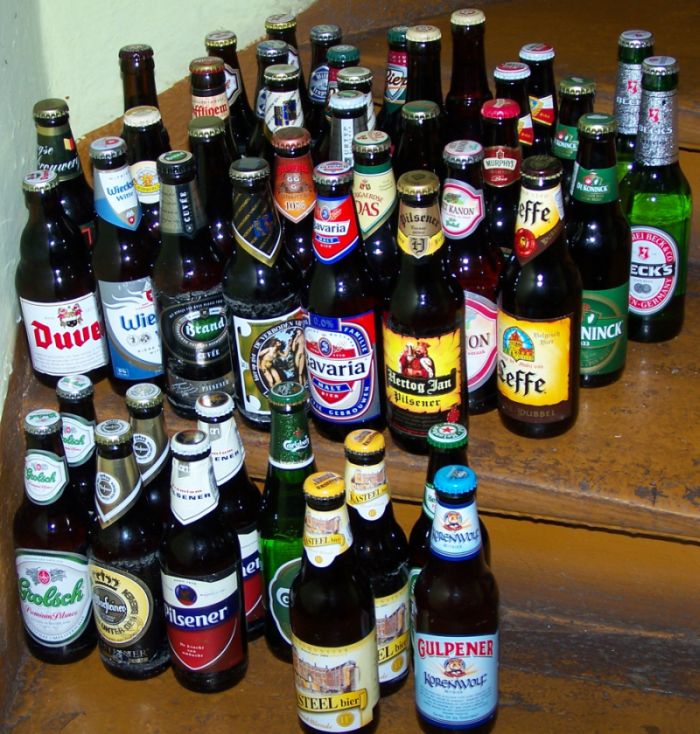Why Beer Comes in Brown (or Green) Bottles

Pictured above is someone’s collection of beer bottles, shared on Wikipedia (here). You’ll quickly note that almost all of them are brown, except for three or four green ones. If you take a trip to the beer section in your local grocery store, you’ll see something similar; lots of brown bottles and a handful of green ones mixed in.
Why?
Science. And a bit of marketing on the side.
If you’re a beer drinker, you’ve probably had the unfortunate experience of drinking “skunky” beer — when your beer has an unexpected and unwanted musty aroma and flavor. For the beer drinker, the experience is a bad one; skunked beer may find its way down the drain more often than not. And for the beer maker, it’s similarly bad news; if consumers have a bad experience with your product, they’re less likely to buy it again.
Not wanting to disappoint or lose customers, beer manufacturers have long taken efforts to prevent this from happening. And the solution, basically, is a big pair of sunglasses. Skunked beer is more formally called “lightstruck” beer, a name used because light — and specifically, UV rays — are the culprit that causes our beer to turn to the foul side. (If you want more of the science, CNN explains that skunking happens “when hops in beer are exposed to strong light, a photooxidation reaction takes place, creating the compound 3-methyl-2-butene-1-thiol.”) As VinePair jokes, “while humans can slather on the SPF 50 and wear hats the size of small boats, we can’t quite do the same for our beer.” Instead, we use tinted glass bottles to prevent the UV rays from having a large impact on the liquid inside.
And the color of that tint matters. Dark brown bottles block more UV light than other bottles, and therefore, are the most popular ones for bottlers to use. Green bottles are notably less effective and clear bottles provide no protection at all.
So, why do some companies use green bottles? Mostly for branding reasons. During World War II, many European companies found their manufacturing processes and supply chains disrupted, and beer companies were no exception. Brown glass was hard to find, and as VinePair also notes, the shortage “forced European brewers to bottle their beer in green or clear glass.” The green glass typically costs extra, so higher-end beers switched to green while cheaper alternatives went with the transparent option. When the war ended and brown glass became available again, some of the green-bottled beers decided to stick with their now-familiar color in an effort to maintain that “premium” branding.
Many beer bottles today — even clear ones — can be sprayed with a UV protection coating, so it may be okay to buy a non-brown beer bottle if you’re really afraid of skunking. And many brands will wrap their bottle in cardboard to help block the light, or label their packaging with a “best by” date that estimates the impact of light over time. But if you’re a fan of beer that comes in no-brown bottles and you don’t want to risk a skunky drink, there’s another solution: buy it in cans. They block almost all the UV rays.
Bonus fact: On March 1, Iceland informally celebrates Bjordagur, or in English, “Beer Day.” It marks the day in 1989 when beer sales were permitted in the small island nation. In 1915, Iceland banned the sale of all intoxicating liquors, as many other nations did around the same time period. As the BBC explains, though, the ban was short-lived — “the Spanish threatened to stop importing salted cod – Iceland’s most profitable export at the time – if Iceland did not buy its wine. Politicians bowed to the pressure and legalized red and rose wines from Spain and Portugal in 1921.” And most other types of alcoholic drinks were permitted by 1933. But beer remained unavailable, at least legally, for decades. Per the BBC, “the fear was that legalizing it would lead to a big rise in alcohol abuse,” and that beer was associated strongly with Denmark, the nation that Iceland had just won its independence from a few decades earlier. Those reasons ultimately gave way to consumer demand.
From the Archives: Beer Bricks: Heineken comes in green bottles — and some of them can be used to make houses.
